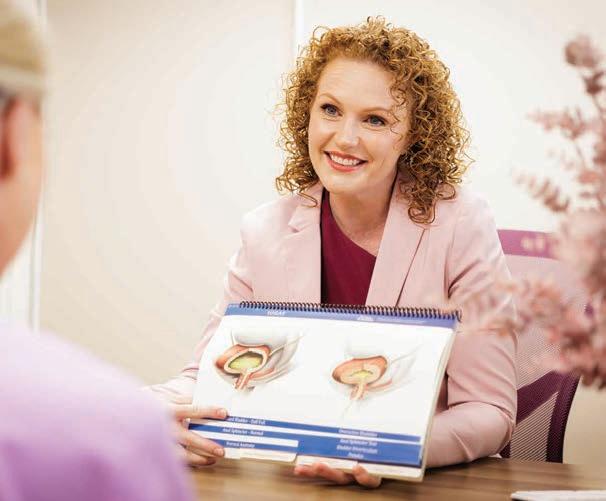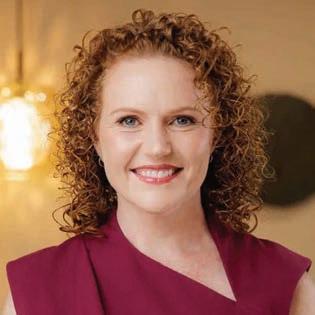
9 minute read
What is Sacral Nerve Stimulation?
Urinary or faecal incontinence does not have to rule your life. It can often be treated, better managed, or even cured. There are new and innovative treatments available, as well as the tried and tested methods. From lifestyle changes and physiotherapy, to medications, non-invasive treatments and surgery.
We talked to Dr Bernadette Brown, from Gold Coast Urogynaecology, who specialises in sacral nerve stimulation (SNS)—one of the treatments offered to patients to give them better control over their bladder and/or bowel.

What is sacral nerve stimulation (SNS)?
Sacral nerve stimulation (also called sacral neuromodulation) is like a pacemaker for your bladder or your bowels. It involves placing a small lead in the lower back along the bladder and bowel nerve (S3 nerve root) which then connects to a battery placed under the skin. The lead sends electric impulses along the nerve—just like a pacemaker sends electric impulses through your heart muscles.
Sacral nerve stimulation can be used in male and female patients who present with:
• Overactive bladders (when you are constantly rushing to the toilet and experiencing bladder leakage before you get there).
• Underactive bladders (when bladders do not empty well enough on their own).
• Bowel symptoms such as bowel (faecal) urgency or accidental bowel leakage (faecal incontinence).
Q: How does sacral nerve stimulation (SNS) work?
A: While we do not know exactly HOW it does it, we know that sacral nerve stimulation improves the communication or signals travelling between the brain and the bladder (or brain and the bowel) through stimulation of the S3 nerve root.
Your specialist will usually suggest a test phase (called a basic evaluation or advanced trial, depending on the method used) before proceeding with a full implant. The leads are all placed under x-ray guidance in an operating theatre, and then tested to make sure they are placed near the S3 nerve. If your symptoms improve by at least 50% over the trial period (1-2 weeks) then your specialist will discuss proceeding with the permanent implant.
Placing a sacral nerve stimulator is considered a minimally invasive procedure. The basic evaluation placement requires no skin incisions, whereas the full implant will have a small skin incision where the lead is placed, and a skin incision of approximately 7cm for placing the pulse generator.
Once the permanent implant has been inserted, you will usually be seen every few months to trial different programs or settings on the device, to ensure we find the optimal program for your bladder or bowel symptoms. Most of the modern devices have a lifespan of more than 10 years.
Patients often worry that the device and controller will be too complex for them to manage. I can reassure you that you have nothing to worry about here—if you can adjust the channels on your television or make phone calls on your smartphone, you will have no problems.
Q: What are the risks, benefits and alternatives?
A: All treatments may have potential side effects so it is important to discuss all these treatments with your specialist to ascertain which will be most suitable for you. Your specialist may recommend further bladder testing procedures such as cystoscopy (a small camera used to look inside your bladder) or urodynamic studies (tests to look at how your bladder and urethra are working).
For overactive bladders, we follow a stepwise treatment approach that involves:
1. Lifestyle modifications such as reducing bladder irritants (caffeine, fizzy drinks and alcohol); as well as bladder training and urge deferral techniques (which aim to reduce urgency and increase time between trips to the toilet). These are undertaken with a pelvic health physiotherapist or a nurse continence specialist.
2. Medications to reduce bladder spasms (such as anticholinergics or B3 agonists). There are other types of nerve stimulator treatments available, such as transcutaneous- or percutaneous tibial nerve stimulation involving the ankle. Finally, we have the option of Botox injections into your bladder to relax it.
3. Sacral nerve stimulation is a highly effective third-line treatment option for overactive bladder symptoms, with more than 85% of patients proceeding with a full implant following the test phase.
Colorectal surgeons treat bowel urgency and accidental bowel leakage. It is important to diagnose the underlying cause of bowel symptoms. Interestingly, both diarrhoea and constipation can lead to bowel urgency and leakage. Your specialist will usually recommend a colonoscopy (a small camera to look in your bowel) if you have not recently had one.
Initial treatment of bowel symptoms will often include:
1. Stool bulking agents such as regular fibre supplements. They may also suggest a trial of loperamide or an anti-diarrhoea medication. Seeing a pelvic health physiotherapist to learn to coordinate pelvic floor muscles may be hugely beneficial.
2. Your specialist may recommend further bowel testing such as endo-anal ultrasound scan and anal manometry. These tests assess the muscle and nerve function of the anal sphincter (the “valve muscle” around the anus) and the lower rectum.
3. Sacral nerve stimulation is a remarkably effective third-line treatment option for bowel urgency and incontinence, with studies suggesting 85% of patients will experience more than 50% improvement in their symptoms following treatment. Up to 40% of patients are cured of bowel leakage.
Q: Since approval for use in 1994, how has the SNS device changed?
A: The first sacral nerve stimulator device used in Australia was the Medtronic InterStim Therapy. Initially, surgeons had to do an incision over the sacrum (tailbone) and dissect the tissues down to the level of the bone to insert the lead to the S3 foramen. The lead was stitched to the ligaments and fascia (or structures) around the sacrum using a permanent suture to prevent the lead from moving. The first significant advancement of the InterStim in 2003, was the development of a tined lead which is self-anchoring (no need for sutures). The InterStim II device was introduced in 2007 – making the pulse generator 50% smaller than the original InterStim. The InterStim II lasted 5-7 years. In 2021, Medtronic introduced a rechargeable battery to the Australian market. The InterStim X is a non-chargeable battery introduced in 2023, with a battery life of more than 10 years. Axonics joined the Australian SNS market in 2023, they also offer a rechargeable and recharge-free battery option.
The InterStim II device initially allowed MRI scanning of the head and neck only, meaning patients who needed MRI scans of their lower backs, for instance, had to have their SNS devices removed. Now both Axonics and Medtronic devices are fully MRI compatible (when switched to MRI mode), which has made this treatment even more appealing for a greater range of patients.
Q: How has the surgical procedure and after-care developed and changed?
A: The surgical procedure has evolved from an open procedure with full general anesthetic to a minimally invasive procedure. With the modern-day minimally invasive method, some patients may be suitable to have a sedation anaesthetic instead. The minimally
“Urinary and faecal incontinence (bladder and bowel leakage) may be more common than you think, but they are not something you have to live with. If you have either of these symptoms and they are impacting your quality of life, do not wait any longer to talk to your doctor. Chances are there will be a treatment available to improve your symptoms.” invasive technique allows placement of the device, often in less than an hour (but this will depend on your anatomy, previous back surgeries and other spinal conditions). Sacral nerve stimulation can now be done as a day case procedure, but this will depend on your specialist’s usual care.
Q: What questions should patients be asking their healthcare team when considering SNS?
A: You should make sure that your specialist has discussed all treatment options with you, so that you can make an informed decision about your treatment. Overactive bladder and bowel urgency, as bothersome as they are, are conditions that affect your quality of life (rather than life-threatening conditions). Take your time to make the decision that is right for you.
Ask your specialist which device they will be using. Ask about follow up and how this will be conducted—sacral nerve stimulation is a long-term treatment. Ask what support will be available, both from a medical point of view as well as the device point of view. Ask about your specialist’s experience with sacral nerve stimulation and the outcome of their patients.
Q: How do you see treatments for incontinence developing over the next 50 years?
A: The success of sacral nerve stimulation has paved the way for testing implantable stimulators on different nerves that supply the pelvic area, including the tibial nerve (nerve in the leg) and the pudendal nerve (nerve in the genitals and anus). These treatments are not yet available in Australia but may offer alternatives to sacral nerve stimulation. Initial studies are very promising.
There is interesting work being done on the bladder biome. Just like the 'gut biome', the bladder biome refers to the normal bacteria that usually live in the bladder (not causing infections). Early evidence suggests that a disruption in this biome may contribute to developing overactive bladder symptoms. Perhaps, in another few years, we will find the 'perfect' bladder biome and be able to replicate this to relieve overactive bladder symptoms.
Q: What advice can you give people when going to the GP initially to talk about incontinence. What should they expect and what should they be asking for?
A: Patients often feel embarrassed when they talk about bladder or bowel symptoms. The first piece of advice I would offer, is try not to be shy when you talk to your doctor. We understand it is a sensitive subject, but the more specific you are about your symptoms, the better we can help you find a solution. Ask for a longer appointment when you go to see your GP—with bladder and bowel conditions, a thorough history and examination takes time, as there are several factors that can contribute to your symptoms.
If your initial therapies or treatments have not had the desired improvement, ask for a second opinion. If your doctor refers you to a specialist, it is important to see the right person. A colorectal surgeon looks after bowel urgency and accidental faecal incontinence. Female patients with urinary incontinence can see a urogynaecologist or a gynaecologist with special interest in urogynaecology. Urologists see male and female patients with urinary incontinence.
For urinary and faecal incontinence (bladder and bowel leakage), I have seen time and time again, where pelvic floor physiotherapists have worked their magic and patients have not needed any further treatments.
If you experience urinary or faecal incontinence get free, confidential advice from a nurse continence specialist. Call the National Continence Helpline 1800 33 00 66 Mon-Fri 8am-8pm AEST.










